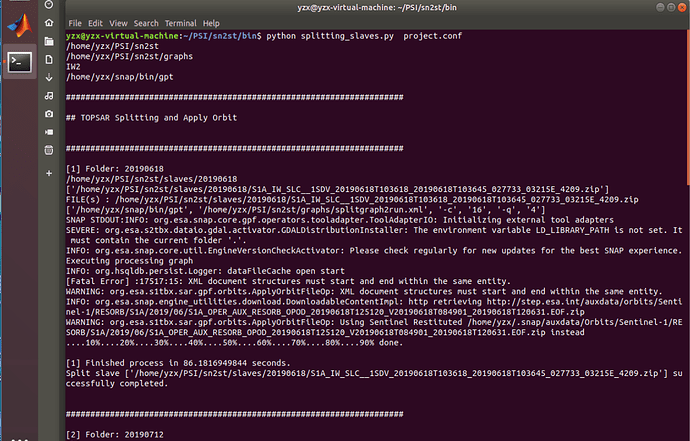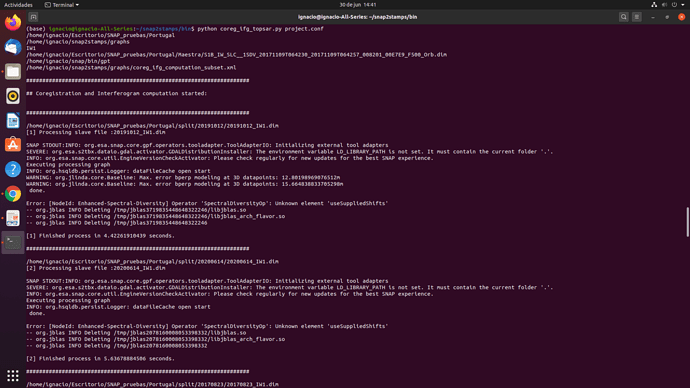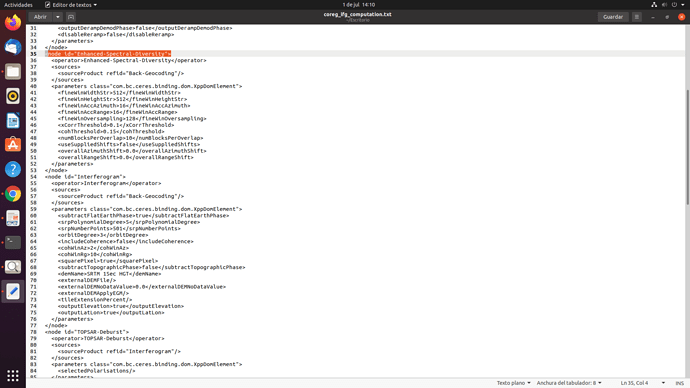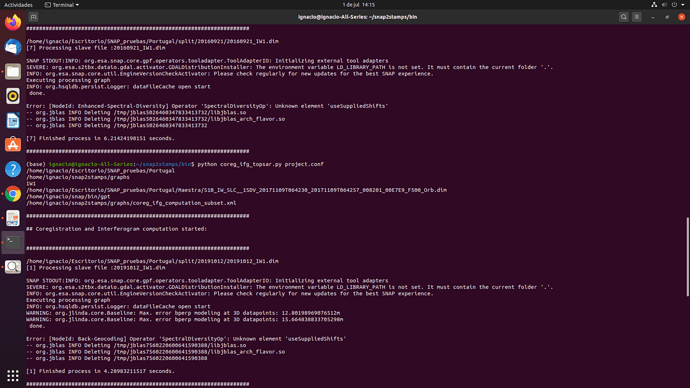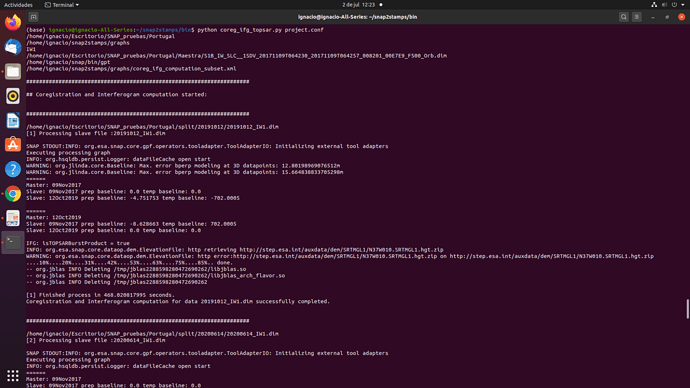in snap2stamps folder/graph, find “coreg_ifg_computation_subset.xml” and replace "
useSuppliedRangeShift" line with two new lines with new names, as Abdel’s answer.
I understand, but I was referring to the error that MosiGitup pointed out, that is, an error like the following.
Error: [NodeId: StampsExport] The Product ‘_20171006_IW2’ already contains a band with the name ‘i_20171006.rslc’.
I am facing the same error. Did not find a solution yet. I am using snap2stamps scripts.
Thanks for your comments, mdelgado.
Well, it is not quite easy to find the exact question&answer given the length of each topic, maybe I missed something of how to use this forum effectively.
Your error can be caused when the master image zip file is inside the slave folder. This creates one image pair with master-master interferogram, leading to the error you mentioned.
Please have a look here: Error: [NodeId: StampsExport] The Product ‘_20171006_IW2’ already contains a band with the name ‘i_20171006.rslc’
Hi,how to run snap2stamps scripts such as “python slaves_prep.py project.conf” while slaves folder( contain zip files ) is outside the PROC folder?
my folder’s structure blow:
project folder: e:\proc
master: e:\proc\master\20190817_orb_spl.dim
snap2stamps: d:\software\snap2stamps-1.0.1\bin
d:\software\snap2stamps-1.0.1\graphs
slaves: e:\data\s1a\PSI\slaves
gpt: c:\Program Files\snap\bin\gpt.exe
soft enviroment: win10 snap7
Or it is recommanded to run snap2stamps scripts in ubuntu?
the only purpose of the project folder is to define where the slaves folder is located. Accordingly, you have to change the project folder in the conf file to
e:\data\s1a\PSI\
or move the slaves folder to
e:\proc
ok ,thandk you .
the other question:in “python splitting_slaves.py project.conf” ,I meet Fatal Error
[Fatal Error] :17517:15: XML document structures must start and end within the same entity.
but the final note is “Split slave [’/home/yzx/PSI/sn2st/slaves/20190618/S1A_IW_SLC__1SDV_20190618T103618_20190618T103645_027733_03215E_4209.zip’] successfully completed.”
I’m not comfirm the progress is right
I’ve repair coreg_ifg_computation.xml and coreg_ifg_computation_subset.xml as @szw mentioned.
soft enviroment:ubuntu18 snap7
If you are working with SNAP 7 indeed you still need to play with the xml for the coreg part.
However, you were splitting slaves so you should not touch xmls.
Probably you did and you forgot to close some xml tags, and the fatal error comes from there.
Be careful and pacient! Soon it will be snap2stamps for SNAP 7 and python 3
in the end ,coreg and other related folder is empty except split folder
here are two xml files:
1/coreg_ifg_computation.xml:
10
<useSuppliedRangeShift>boolean
double
<useSuppliedAzimuthShift>boolean
double
2/coreg_ifg_computation_subset.xml
10
<useSuppliedShifts>false
<useSuppliedAzimuthShift>false
0.0
0.0
question1:are changes right above ?
2/shall I repair coreg_ifg2run.xml also?
3/I know the next release snap2stamps,but so eager to cant wait
I found this pull request in github which you seem to have updated the .xml. Can I use it to replace the existing one?
Good
I’m taking my first steps in all the interferometry radar work, including programming and Linux, so if I’m a little lost, excuse me.
I don’t know exactly what the problem is so I get this error by following the steps in the manual.
SNAP STDOUT:INFO: org.esa.snap.core.gpf.operators.tooladapter.ToolAdapterIO: Initializing external tool adapters
SEVERE: org.esa.s2tbx.dataio.gdal.activator.GDALDistributionInstaller: The environment variable LD_LIBRARY_PATH is not set. It must contain the current folder ‘.’.
INFO: org.esa.snap.core.util.EngineVersionCheckActivator: Please check regularly for new updates for the best SNAP experience.
Executing processing graph
INFO: org.hsqldb.persist.Logger: dataFileCache open start
WARNING: org.jlinda.core.Baseline: Max. error bperp modeling at 3D datapoints: 12.80198969076512m
WARNING: org.jlinda.core.Baseline: Max. error bperp modeling at 3D datapoints: 15.664838833705298m
done.
Error: [NodeId: Enhanced-Spectral-Diversity] Operator ‘SpectralDiversityOp’: Unknown element ‘useSuppliedShifts’
– org.jblas INFO Deleting /tmp/jblas3719835448648322246/libjblas.so
– org.jblas INFO Deleting /tmp/jblas3719835448648322246/libjblas_arch_flavor.so
– org.jblas INFO Deleting /tmp/jblas3719835448648322246
are you working on a single burst? In this case you don’t need the ESD operator. Please see here: Workflow between SNAP and StaMPS
sorry for the new question but where should i look for the xml file?
inside the graphs folder of snap2stamps, look for the coregistration script (make a backup at best)
I have modified the xml but it still gives me the same problem.
I am not entirely sure if I should modify the first Enhanced-Spectral-Diversity (I have tried it both ways without modifying it and modifying it by putting Back-Geocoding) however I think that maybe it is a problem of
The environment variable LD_LIBRARY_PATH is not set. It must contain the current folder ‘.’.
As long as I make the modification that I make, that problem continues to appear
What could I be doing wrong?
In your screenshot the file ends with txt, so maybe the scripts still make use of the original one which ends with xml?
Similar to this case: Snap2stamps package: a free tool to automate the SNAP-StaMPS Workflow
At the end the solution has been to uninstall snap 7 and install version 6. At least I have been able to get results.
However, a series of warnings appear that I am not sure if they are important or not.
WARNING: org.jlinda.core.Baseline: Max. error bperp modeling at 3D datapoints: 12.80198969076512m
WARNING: org.jlinda.core.Baseline: Max. error bperp modeling at 3D datapoints: 15.664838833705298m
and
WARNING: org.esa.snap.core.dataop.dem.ElevationFile: http error:http://step.esa.int/auxdata/dem/SRTMGL1/N37W010.SRTMGL1.hgt.zip on http://step.esa.int/auxdata/dem/SRTMGL1/N37W010.SRTMGL1.hgt.zip
Finally I would like to ask one last question:
What should it be approximately
the maximum baseline prep: and the maximum baseline temp :?
this occurs quite often, but does not necessarily mean bad results. You can proceed, but have a close look at the data during the processing.

